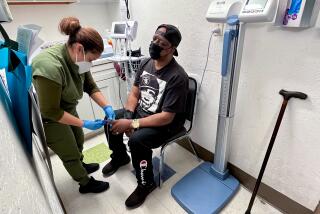Congenital heart disease screening recommended for newborns
- Share via
Before newborns leave the hospital, they should receive a simple, pain-free test to check for signs of congenital heart disease, one of the most common types of birth defects, according to a recommendation by a federal advisory panel.
In a report published online Sunday in the journal Pediatrics, the doctors propose nationwide screening for critical congenital heart disease using pulse oximetry, a probe placed on a hand and a foot that uses a light source and sensor to measure oxygen in the blood. Low oxygen levels signal the need for further testing to look for a heart-related problem.
Although questions remain about the optimal way to implement the screening, the issue has been pushed onto thenational stage by parent groups that favor it. In addition, some states — which have jurisdiction over newborn screenings — have acted on their own to implement programs. New Jersey and Maryland recently passed laws requiring pulse oximetry screening, and similar bills are being considered in other states.
Congenital heart disease involves defects of the walls, valves, arteries or veins of the heart and occurs in seven to nine of every 1,000 live births in the United States. About a quarter of those babies have a critical illness, said Dr. Alex Kemper, an associate professor of pediatrics at Duke University and the lead author of the report.
“Those defects are the ones that really require intervention early in life,” he said. “The challenge is that a baby can be born with one of these heart defects and look totally normal in the nursery. But if you can fix these kids before they get really sick, they have better outcomes.”
Many cases of critical congenital heart disease involve a blood vessel called the ductus arteriosus. This vessel bypasses the baby’s lungs when in utero and closes shortly after birth. But in some cases, it remains open. If undiagnosed, the condition can cause organ damage or death. The condition and other types of critical congenital heart defects can be treated with medication or surgery.
“Over the last three decades, we’ve had incredible advances in treatment,” said Dr. Gerard Martin, co-director of the Children’s National Heart Institute in Washington, which has pioneered the use of newborn pulse oximetry screening. “This is a disease we can do something about. The problem is not all babies are identified.”
Studies show about 1 in 6 babies who die from critical congenital heart disease are undiagnosed, and unrecognized cases are thought to cause about 200 infant deaths each year, he said. An estimated 2,000 babies a year could be diagnosed sooner if pulse oximetry were routinely used.
The downside of pulse oximetry screening is that, while clearly useful in detecting the disease, it can also lead to false positive results that are costly and stressful for a family. But several large studies in Europe, including a study of more than 20,000 newborns in Britain published this month in the medical journal Lancet, showed that pulse oximetry had a high rate of detection when added to standard exams and a false positive rate of about 1 in 3,000 cases, Martin said.
“Hospitals that use pulse oximetry in addition to a physical exam can increase their detection of these babies tenfold,” Martin said. “There will be some babies potentially missed. But what the European studies showed is the babies who had false positives had other problems that required detection and treatment.”
However, false positives are of concern because smaller hospitals may not have the means to conduct more sophisticated cardiac testing, thus requiring the transfer of some babies for additional tests that may prove to be unnecessary.
“False positives are particularly bad because not all hospitals or nurseries will have access to pediatric echocardiograms or pediatric cardiologists,” Kemper said. “We want to minimize unnecessary tests.”
The new report, which was endorsed by the American Academy of Pediatrics, the American College of Cardiology Foundation and the American Heart Assn., is now in the hands of Health and Human Services Secretary Kathleen Sebelius. The panel suggests a screening protocol that combines pulse oximetry with the usual physical examination, the authors said. To maximize the accuracy of the results, the report recommends screening newborns in the second day of life instead of 12 hours after birth, a method tested in some studies.
The report also recommends cutoffs for what is considered low oxygen saturation. However, those numbers may not translate well to regions in which high altitude naturally lowers oxygen saturation, the report said.
Moreover, hospital nurseries that adopt the recommendations will need to purchase screening equipment and create a system to test babies and refer those who need further evaluation. Some hospitals have already adopted pulse oximetry. But others will probably wait for recommendations from state newborn screening programs, Martin said.
More to Read
Sign up for The Wild
We’ll help you find the best places to hike, bike and run, as well as the perfect silent spots for meditation and yoga.
You may occasionally receive promotional content from the Los Angeles Times.










